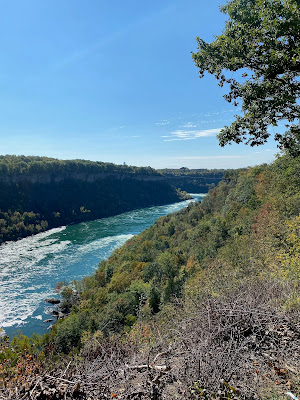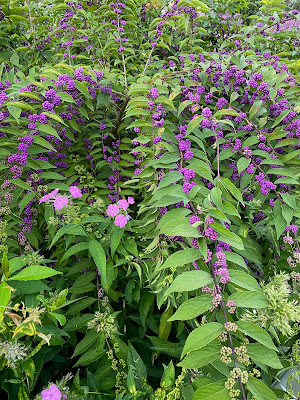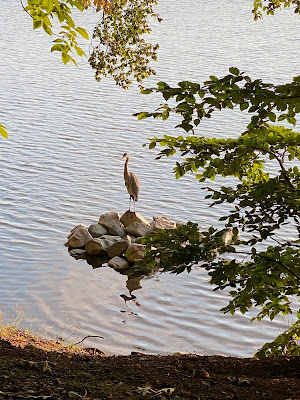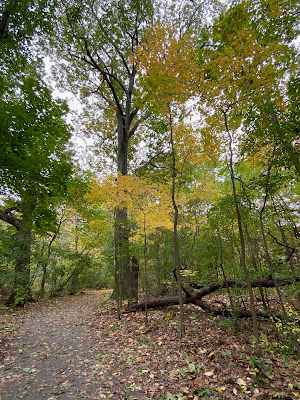October 2021
October 2 The beautyberry bushes in my garden are full of their tiny purple berries now, looking their best.
October 3 The morning sky on my walk with Maddie. I must have left a bit later than usual; it's normally still dark when I head out these mornings.
October 6 The pond, still as glass, this morning.
Biking home from MIT this afternoon, saw a male wood duck, in all his splendour, paddling along the Muddy River. I hadn't seen one in months as the US Army Corps of Engineers has been dredging and replanting along the Muddy River.
Heard a screech owl whinnying in the night, just outside my bedroom window.
October 9 Walking to the pond, saw a chipmunk perched on a bush in a neighbor's yard, very cooperative, quite still while I took a couple of photos. Until a few years ago, there were no chipmunks (or rabbits or turkeys) in our neighborhood, but now they're all over the place.
At the pond, a great blue heron standing on a rock pile.
And a woolly bear caterpillar, making its (slow) way across the footpath.
I was surprised to see it, thinking that it's getting colder and they should be tucked away somewhere by now. And here's what the National Weather Service has to say about them:
"According to folklore, the amount of black on the woolly bear in autumn varies proportionately with the severity of the coming winter in the locality where the caterpillar is found. The longer the woolly bear's black bands, the longer, colder, snowier, and more severe the winter will be. Similarly, the wider the middle brown band is associated with a milder upcoming winter. The position of the longest dark bands supposedly indicates which part of winter will be coldest or hardest. If the head end of the caterpillar is dark, the beginning of winter will be severe. If the tail end is dark, the end of winter will be cold. In addition, the woolly bear caterpillar has 13 segments to its body, which traditional forecasters say correspond to the 13 weeks of winter.
As with most folklore, there are 2 other versions to this story. The first one says that the woolly bear caterpillar's coat will indicate the upcoming winter's severity. So, if its coat is very woolly, it will be a cold winter. The final version deals with the woolly bear caterpillar's direction of travel. It is said that woolly bears crawling in a southerly direction are trying to escape the cold winter conditions of the north. On the other hand, woolly bears crawling on a northward path would indicate a mild winter."
I see a wide middle band and it was heading north, forecasting a mild winter. Sounds good to me, although I have to say I'd never heard of any of this before.
October 10 Started my trip to Canada to visit family and friends. Well, and of course to bask in beautiful nature spots along the way. First up, Montezuma National Wildlife Refuge, an extensive marsh at the northern end of the Finger Lakes. I was hoping to see migrating ducks and, maybe, if I was lucky, snow geese. Arriving around 4pm, stopping at one of the first pools, there were great egrets, great blue heron, green-winged teal, a couple of gadwalls, lots of Canada geese and mallards. Here is one particularly cooperative egret.
Then, as I drove on, I noticed a couple of cars parked a little way up ahead. And as I drew closer, I saw what they were looking at and said "oh, wow" to no one in particular: 3 sandhill cranes, standing at an opening in the marsh grasses, less than 100 feet away, posing, preening, being incredibly cooperative. I've seen sandhill cranes in the West before, thousands of them wintering at Bosque del Apache in New Mexico and a few doing their courtship leaping dances in June in the Tetons, but never any in the East. So great to see them.
October 11 Approaching the refuge the next morning just after sunrise, long, long strings of Canada geese, one after another, high in the air, heading south. At the refuge itself, great commotion, honking filling the air, as each group started to take off, scattered at first, then drawing together into a string or V formation.
A little further into the refuge, wave after wave of black birds flying low overhead. I wasn't sure what they were until I noticed flashes of red: thousands of red-winged blackbirds going by in the space of the ten or fifteen minutes I stood there, mesmerized. Another highlight - 5 bald eagles: one flying over the marsh in the distance; a pair perched at the top of a huge dead tree, just taking in the scene; and a second pair at a pond, one on dead stump, the other standing on a slight mound at the edge of the pond, across from the first one. By the time I left the refuge to drive on to Niagara, I was beaming with the pleasure of it all.
Crossed the border at the Queenston-Lewiston bridge, just a few miles downstream from the Falls, happy to be back in Canada again. I'm staying in Queenston, where the Niagara escarpment meets the river, to revisit the places my parents took us walking as kids. I love the view of the river from here.
This afternoon I walked the first little bit of the Bruce Trail, which runs 900 km along the length of the escarpment to the northern tip of the Bruce Peninsula; you can see its northwestern route up the peninsula in this map of the Greenbelt area around Toronto.
The path follows the top edge of the escarpment, so that as you walk along, down the slope you're always seeing the lush, dense green of the nearby low bushes and the tops of the trees growing further down. And on the other side, a mature hard woods, maples and oaks, some huge downed trunks decaying. Birds calling, insects chirping.
After dinner in Niagara-on-the-Lake, driving back along the river, an amazing sunset. In the plain below the escarpment, the vineyards that were just starting out when I was a kid, now matured, supply dozens of wineries. I remember dump trucks stacked with plastic bins full of grapes passing by this time of year, trailing the smell of grapes.
October 12 I always loved our family walks down the Niagara Glen. A staircase leads down the initial cliff and then steep trails with stone steps go down to the river, right by the rapids. More beautiful hardwood forest, strewn with huge boulders that have fallen off the cliff over time. When I was a kid, few tourists went there and it felt like a hidden, magical place. This afternoon I returned, feeling that same sense of wonder.
 | |
| View from the top of the Glen |
 | |||||||
| The new and improved staircase that has replaced the old rusty steel stairway with just a handrail. | |
Hurtling, churning water, blasting through the gorge. Close up like this, you get a sense of the river's immense power. The hydro stations on both sides of the river generate forty five hundred megawatts, enough to power four hundred 747 engines.
And I suppose I would be remiss if I didn't go to the Falls, so here I am.
October 13 Morning walk just after sunrise, down to the Queenston dock. Surprisingly, the water on the Canadian side of the river flows upstream, although more slowly than the water flowing downstream on the American side. And in the midst of a central swirl, the water is almost still. Among birders, the river is known for gulls in the fall, up to twelve species, by the thousands. There are not thousands this morning but still a good number, occasionally alighting on the water. Some, on the American side, moving with it fast downstream. Others on the Canadian side, moving more slowly upstream. And occasionally, one lands in between staying almost stationary. It reminds me of what fluid mechanics people call "particle image velocimetry" where small particles distributed in a fluid are videotaped as the fluid flows, tracking its path. But with gulls, in the place of particles.
Went to Ball's Falls this morning, about a half hour west of here, also along the escarpment. All the streams and creeks that flow from Lake Erie to Lake Ontario pass over the escarpment in a waterfall, not with the power and drama of Niagara, but still beautiful in their own way. The photo is of the lower falls; I couldn't get a photo of the upper falls without climbing over the safety wall past the Danger signs (although I did see one couple doing just that, giving me the heebie jeebies).
As a kid, we often went to Ball's Falls, one time in the spring even seeing the great, writhing balls of snakes that Ball's Falls is known for. Today, no snakes, but I did see a couple of giant puff balls, the size of a soccer ball.
Later on in the day, I went to a little art gallery in Queenston that was mostly drawings and paintings of this area from the 1700s on. There was an old map of the river between the Falls and Queenston, complete with descriptions of the water: from above the falls, "begins to ripple"; to, before the falls, "dashing and foaming rapids"; to just before the precipice, "smoother" and then, downstream, up to the whirlpool, "violent current".
October 14 Heard a screech owl whinnying for a few minutes outside my window in the night. Drove to Toronto today, stopping at Cootes' Paradise nature sanctuary, surrounding the bay at the very most western tip of Lake Ontario. At my first stop saw an osprey in a large dead tree, overlooking a little pond area. And when I looked more closely, I noticed a smaller raptor, higher up in the tree: a peregrine falcon! Very exciting. It stayed there for another 20 minutes or so, allowing me to get a good look through the telescope, before taking off. Afterwards, I walked along the shore of Cootes' Paradise for a bit, near the Arboretum, part of the Royal Botanical Gardens. Saw a great egret and great blue heron, but not much else.
October 16 Visiting with my friends Alison and Gilbert who live out in the woods in Gooderham, between Toronto and Ottawa. Walking on their property, Alison pointed out this beech tree with bear claw marks going up the trunk.
October 17. Walked about 2 miles along an old railway line, next to a river this morning. Didn't see anyone the entire time. But did see this fresh bear poop.
One of the three lakes within a 5 minute drive of Alison and Gilbert's house. Their dog, Loki, admiring the scene.
October 19. Cold this morning, ice on the little bird bath at Alison and Gilbert's yard.
October 22 Drove from Ottawa to Saranac Lake in the Adirondacks today. Going by Church Pond at Paul Smiths, noticed several splashes and then wakes on the water. Stopped the car to take a look: 15 common mergansers, females and maybe some juveniles, all in a group, landed on the pond, then diving, coming to the surface, swimming along together. Wonderful!
October 23 Walked from the hotel to Moody's Pond, about half a mile from the hotel. Saw a single loon, molting to its winter plumage of mottled grey, preening its feathers (do they get itchy when they're molting?), occasionally diving. On the way back into town saw a boreal chickadee, with its pinker sides than the usual black-capped chickadee, at the very southern end of its range, and a hairy woodpecker.
Saranac Lake, with its clean mountain air, was the home of a tuberculosis treatment center from the late 1880s until the development of drugs to treat the disease in the 1940s. The Adirondack Cottage Sanatorium, founded by Dr. Edward Livingston Trudeau, housed patients in small "cure cottages" rather than a large institutional setting. The Saranac Laboratory, the research facility of the treatment center, is now a museum; the poster on the left of the building, Pandemic Perspectives, advertises its current exhibit comparing tuberculosis and covid.
And across the street is an Episcopal church, The Church of St Luke the Beloved Physician. I didn't know this before, but Wikipedia tells me that some think that St. Luke was a Greek physician in Antioch, in ancient Syria.
Walked a couple of trails at the Visitor Information Center at Paul Smith's College but little bird action; the photo is taken from the Heron Marsh trail.
Went to White Pine Camp, where Jeannie and I vacationed many times, enjoying hiking and biking in the area around Paul Smith's. So many great nature notes over the years near the bridge: a pair of loons diving and feeding fish to their young; a bald eagle circling over the tea house, at the far end of the bridge, as we sat in Adirondack chairs right beneath it; a female common merganser with over a dozen juveniles trailing behind her in single file, sometimes all swimming under the bridge to the little bay on the other side; cedar waxwings darting out from the pines near the tea house, over the water, catching insects in the early evening; one morning an otter on the far shore diving and surfacing over and over. We both loved this spot; last year I scattered her ashes from the bridge. And this morning, the pair of loons was up the river, not far away.
Walking around the woods at White Pine Camp, a grouse, probably a ruffed grouse, took off with a great commotion of beating wings that only lasted a few seconds. But I couldn't find it on the ground or in the trees.
One of our favorite bike rides was to head south along Norman Ridge Road, with a view of the High Peaks filling the sky.
October 24 Headed home to Boston, leaving before I had planned as the forecast was for cold, rainy weather for the next few days. When I got in the car to leave, there was a hard frost on the windows and the thermometer was at 27. On the drive towards Lake Placid, a wonderful hoar frost, coating every leaf and twig. Brrr....
Tonight is the annual Lantern Parade around Jamaica Pond, an opportunity for kids to dress up in their Hallowe'en costumes and carry decorated soda bottle lanterns as they walk around the pond. I love seeing the glowing lights across the pond as hundreds of families take part.
October 28. I went to Leverett Pond this morning to see if there were any hooded mergansers, as they usually show up at the end of October or beginning of November. And sure enough, there was a single male, looking classy as ever, with his black and white head, chestnut sides, white breast outlined by lines of black and white, and the delicate, fine white lines on his black wings. Also a great blue heron fishing by the bank of the pond. Being curious about the red-bellied woodpecker nest that I saw in the spring, I went over to take a look and found that the opening was much larger now, maybe large enough for a raccoon, and I wondered if raccoons had clawed at the rotting soft wood to enlarge the hole for themselves.
And one of my neighbors put up this bird for Halloween, taping it to the fence.
October 29. Three pairs of elegant wood ducks at Ward's Pond in JP. And still some fall color in the sassafras trees along the footpath.
































Comments
Post a Comment